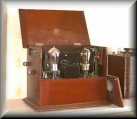Working with stereotype and archetype
|
Stereotypical representation is best challenged by describing its inadequacy to faithfully portray other cultures and people. Similarly, films about minorities, subcultures or segregated social groups often mock the inability to signify through stereotypes.
Stereotypes in Hollywood films (from Internet): In Hollywood films, a fixed and simplified characterization is constantly used and repeated. This is to gain acceptance by mainstream audiences, and is usually "marked" by exaggerated physical features (through makeup), costuming, and acting style. Stereotypes draw on one narrow aspect of a social type, amplify it and thoroughly invest a character with this characteristic. The character's entire motivation is understood through this narrow lens.
There are negative uses of stereotype - note examples relating to race, gender and age. It suppresses the complexities of the social type, for example African American men. It claims the one-dimensional characterization as the whole and the absence of certain characteristics. Because this representation is one-dimensional, it tends to label the type as either "good" (tolerated by the mainstream) or "bad" (feared and/or hated by the mainstream). Stereotypes are not simply used to contain non-dominant social groups; they can also be used to reaffirm mainstream ideology. For example, the Western hero in classical Hollywood cinema is independent, single-minded in pursuit of a goal, resistant of domestic/feminine temptations, and uses violence to gain moral ends. The structuring absence includes moral ambiguity and unregulated anger. This stereotype reinforces notion of white American national superiority (replaying the "civilizing" of the once "savage" West) and masculine dominance.
Anti-genre films can effectively play with spectator expectations by presenting an apparent stereotype and then deviating from it.
At times, a film may seem to challenge a stereotype and then fall back into the expectations of the genre. A film positioning itself as counter-cinema may also re-appropriate a negative stereotype in order to invest it with greater agency. Critics of this strategy have argued that this approach simply serves to reinforce mainstream ideological assumptions, while proponents claim that these presentations turn mainstream assumptions on their head.
|
|
|




